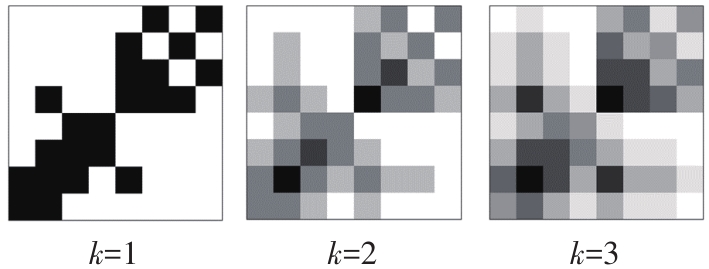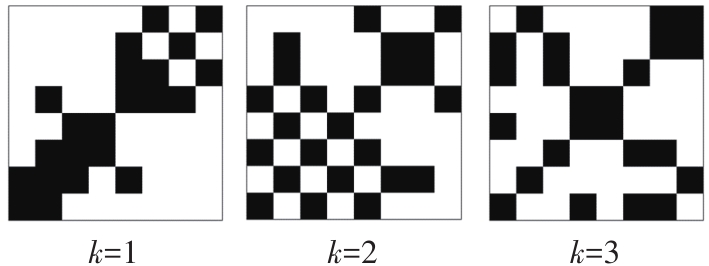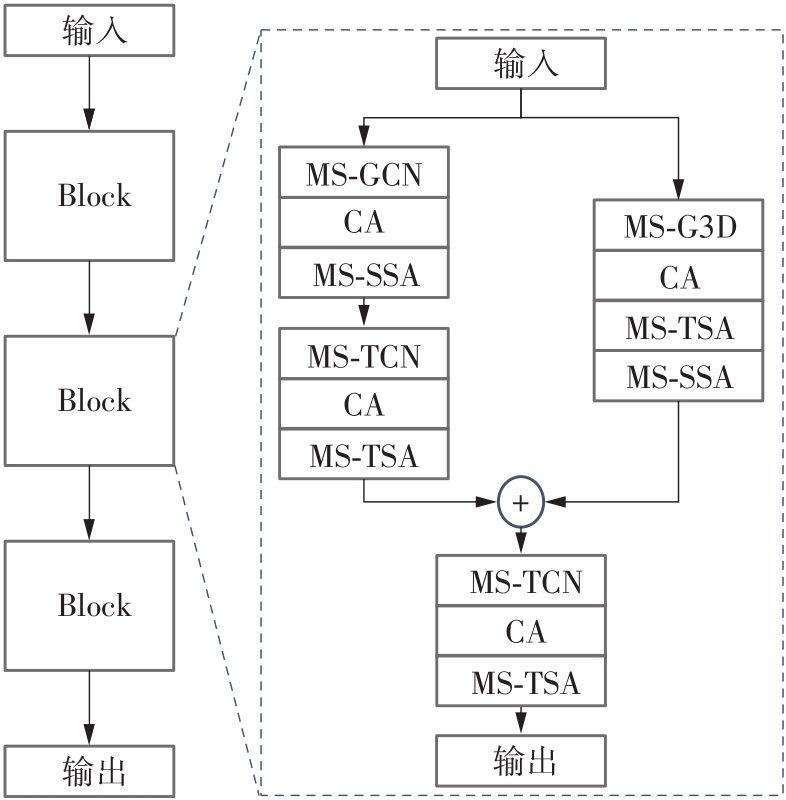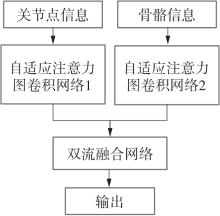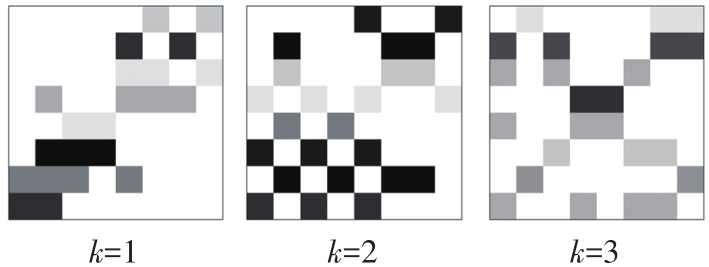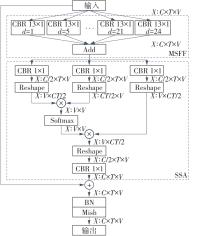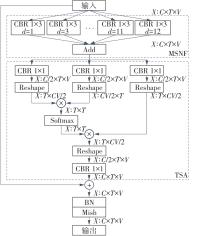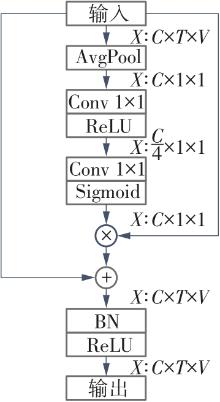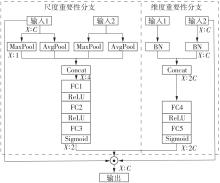Journal of South China University of Technology(Natural Science Edition) ›› 2022, Vol. 50 ›› Issue (12): 20-29.doi: 10.12141/j.issn.1000-565X.220055
Special Issue: 2022年计算机科学与技术
• Computer Science & Technology • Previous Articles Next Articles
Two-Stream Adaptive Attention Graph Convolutional Networks for Action Recognition
DU Qiliang1,2,3 XIANG Zhaoyi1 TIAN Lianfang1,2,4 YU Lubin1
- 1.School of Automation Science and Engineering,South China University of Technology,Guangzhou 510640,Guangdong,China
2.China-Singapore International Joint Research Institute,South China University of Technology,Guangzhou 510555,Guangdong,China
3.Key Laboratory of Autonomous Systems and Network Control of the Ministry of Education,South China University of Technology,Guangzhou 510640,Guangdong,China
4.Research Institute of Modern Industrial Innovation,South China University of Technology,Zhuhai 519170,Guangdong,China
-
Received:2022-02-11Online:2022-12-25Published:2022-04-08 -
Contact:杜启亮(1980-),男,博士,副研究员,主要从事模式识别与机器视觉研究。 E-mail:qldu@scut.edu.cn -
About author:杜启亮(1980-),男,博士,副研究员,主要从事模式识别与机器视觉研究。 -
Supported by:the Guangdong Provincial Special Project for the Development of Ocean Economy(GDNRC[2020]018);the Key-Area R&D Project of Guangdong Province(2019B020214001)
CLC Number:
Cite this article
DU Qiliang, XIANG Zhaoyi, TIAN Lianfang, et al. Two-Stream Adaptive Attention Graph Convolutional Networks for Action Recognition[J]. Journal of South China University of Technology(Natural Science Edition), 2022, 50(12): 20-29.
share this article
Table 4
Comparison of recognition performance on NTU RGB+D dataset"
| 方法 | 准确率/% | |
|---|---|---|
| CS | CV | |
| Lie Group[ | 50.1 | 52.8 |
| Deep LSTM[ | 60.7 | 67.3 |
| ST-LSTM[ | 69.2 | 77.7 |
| VA-LSTM[ | 79.2 | 87.7 |
| IndRNN[ | 81.8 | 88.0 |
| Clips+CNN+MTLN[ | 79.6 | 84.8 |
| CNN+Motion+Trans[ | 83.2 | 89.3 |
| 3scale ResNet152[ | 85.0 | 92.3 |
| Ta-CNN+[ | 90.7 | 95.1 |
| ST-GCN[ | 81.5 | 88.3 |
| DPRL+GCNN[ | 83.5 | 89.8 |
| ST-GR[ | 86.9 | 92.3 |
| 2s-AGCN[ | 88.5 | 95.1 |
| DHGCN[ | 90.7 | 96.0 |
| CD-GCN[ | 90.9 | 96.5 |
| MS-G3D[ | 91.5 | 96.2 |
| AAGCN(J) | 91.2 | 96.7 |
| AAGCN(B) | 91.6 | 96.9 |
| 2s-AAGCN | 92.3 | 97.5 |
Table 5
Comparison of recognition performance on Kinetics-Skeleton dataset"
| 方法 | 准确率/% | |
|---|---|---|
| Top1 | Top5 | |
| Feature Enc[ | 14.9 | 25.8 |
| Deep LSTM[ | 16.4 | 35.3 |
| ST-GCN[ | 30.7 | 52.8 |
| ST-GR[ | 33.6 | 56.1 |
| 2s-AGCN[ | 36.1 | 58.7 |
| DGNN[ | 36.9 | 59.6 |
| GCN-NAS[ | 37.1 | 60.1 |
| Sym-GNN[ | 37.2 | 58.1 |
| DHGCN[ | 37.7 | 60.6 |
| MS-G3D[ | 38.0 | 60.9 |
| AAGCN(J) | 37.3 | 60.1 |
| AAGCN(B) | 36.9 | 59.5 |
| 2s-AAGCN | 39.8 | 62.4 |
| 1 | 朱煜,赵江坤,王逸宁,等 .基于深度学习的人体行为识别算法综述 [J].自动化学报,2016,42(6):848-857. |
| ZHU Yu, ZHAO Jiangkun, WANG Yining,et al .A review of human action recognition based on deep learning [J].Acta Automatica Sinica,2016,42(6):848-857. | |
| 2 | VEMULAPALLI R, ARRATE F, CHELLAPPA R .Human action recognition by representing 3D skeletons as points in a lie group [C]∥ Proceedings of 2014 IEEE Conference on Computer Vision and Pattern Recognition.Columbus:IEEE,2014:588-595. |
| 3 | FERNANDO B, GAVVES E, ORAMAS J M,et al .Modeling video evolution for action recognition [C]∥ Proceedings of 2015 IEEE Conference on Computer Vision and Pattern Recognition.Boston:IEEE,2015:5378-5387. |
| 4 | RUMELHART D E, HINTON G E, WILLIAMS R J .Learning representations by back-propagating errors [J].Nature,1986,323(6088):533-536. |
| 5 | YANN L, BOTTOU L, BENGIO Y,et al .Gradient-based learning applied to document recognition [J].Proceedings of the IEEE,1998,86(11):2278-2324. |
| 6 | SHAHROUDY A, LIU J, T-T NG,et al .NTU RGB+D:a large scale dataset for 3D human activity analysis [C]∥ Proceedings of 2016 IEEE Conference on Computer Vision and Pattern Recognition.Las Vegas:IEEE,2016:1010-1019. |
| 7 | LIU J, SHAHROUDY A, XU D,et al .Spatio-temporal LSTM with trust gates for 3D human action recognition [C]∥ Proceedings of the 14th European Conference on Computer Vision.Amsterdam:Springer,2016:816-833. |
| 8 | ZHANG P, LAN C, XING J,et al .View adaptive recu-rrent neural networks for high performance human action recognition from skeleton data [C]∥ Proceedings of 2017 IEEE International Conference on Computer Vision.Venice:IEEE,2017:2117-2126. |
| 9 | LI S, LI W, COOK C,et al .Independently recurrent neural network (IndRNN):building a longer and deeper RNN [C]∥ Proceedings of 2018 IEEE Conference on Computer Vision and Pattern Recognition.Salt Lake City:IEEE,2018:5457-5466. |
| 10 | KE Q, BENNAMOUN M, AN S,et al .A new representation of skeleton sequences for 3D action recognition [C]∥ Proceedings of 2017 IEEE Conference on Computer Vision and Pattern Recognition.Honolulu:IEEE,2017:3288-3297. |
| 11 | LI C, ZHONG Q, XIE D,et al .Skeleton-based action recognition with convolutional neural networks [C]∥ Proceedings of 2017 IEEE International Conference on Multimedia Expo Workshops.Hong Kong:IEEE,2017:597-600. |
| 12 | LI B, DAI Y, CHENG X,et al .Skeleton based action recognition using translation-scale invariant image mapping and multi-scale deep CNN [C]∥ Proceedings of 2017 IEEE International Conference on Multimedia Expo Workshops.Hong Kong:IEEE,2017:601-604. |
| 13 | XU K, YE F, ZHONG Q,et al .Topology-aware convolutional neural network for efficient skeleton-based action recognition [EB/OL].(2021-12-09) [2022-02-11].. |
| 14 | WU Z, PAN S, CHEN F,et al .A comprehensive survey on graph neural networks [J].IEEE Transactions on Neural Networks and Learning Systems,2021,32(1):4-24. |
| 15 | 杜启亮,黄理广,田联房,等 .基于视频监控的手扶电梯乘客异常行为识别 [J].华南理工大学学报(自然科学版),2020,48(8):10-21. |
| DU Qiliang, HUANG Liguang, TIAN Lianfang,et al .Recognition of passengers’ abnormal behavior on escalator based on video monitoring [J].Journal of South China University of Technology (Natural Science Edition),2020,48(8):10-21. | |
| 16 | YAN S, XIONG Y, LIN D .Spatial temporal graph convolutional networks for skeleton-based action recognition [C]∥ Proceedings of the 32nd AAAI Conference on Artificial Intelligence.Palo Alto:AAAI,2018:7444-7452. |
| 17 | SHI L, ZHANG Y, CHENG J,et al .Two-stream adaptive graph convolutional networks for skeleton-based action recognition [C]∥ Proceedings of 2019 IEEE/CVF Conference on Computer Vision and Pattern Recognition.Long Beach:IEEE,2019:12018- 12027. |
| 18 | LI B, LI X, ZHANG Z,et al .Spatio-temporal graph routing for skeleton-based action recognition [C]∥ Proceedings of the 33rd AAAI Conference on Artificial Intelligence.Hawaii:AAAI,2019:8561-8568. |
| 19 | LI M, CHEN S, CHEN X,et al .Actional-structural graph convolutional networks for skeleton-based action recognition [C]∥ Proceedings of 2019 IEEE/CVF Conference on Computer Vision and Pattern Recognition.Long Beach:IEEE,2019:3595-3603. |
| 20 | WEI J, WANG Y, GUO M,et al .Dynamic hypergraph convolutional networks for skeleton-based action recognition [EB/OL].(2021-10-20)[2022-02-11].. |
| 21 | MIAO S, HOU Y, GAO Z,et al .A central difference graph convolutional operator for skeleton-based action recognition [J].IEEE Transactions on Circuits and Systems for Video Technology,2022,32(7):4893-4899. |
| 22 | LIU Z, ZHANG H, CHEN Z,et al .Disentangling and unifying graph convolutions for skeleton-based action recognition [C]∥ Proceedings of 2020 IEEE/CVF Conference on Computer Vision and Pattern Recognition.Seattle:IEEE,2020:143-152. |
| 23 | VASWANI A, SHAZEER N, PARMAR N,et al .Attention is all you need [C]∥ Proceedings of the 31st Advances in Neural Information Processing Systems.Long Beach:Curran Associates,2017:5998-6008. |
| 24 | LAN Z, CHEN M, GOODMAN S,et al .ALBERT:a lite BERT for self-supervised learning of language representations [EB/OL].(2019-09-26)[2022-02-11].. |
| 25 | LIU Z, LIN Y, CAO Y,et al .Swin transformer:hierar-chical vision transformer using shifted windows [EB/OL].(2021-08-21)[2022-02-11].. |
| 26 | KAY W, CARREIRA J, SIMONYAN K,et al .The kinetics human action video dataset [EB/OL].(2021-05-19)[2022-02-11].. |
| 27 | CAO Z, HIDALGO G, SIMON T,et al .OpenPose:realtime multi-person 2D pose estimation using part affi-nity fields [J].IEEE Transactions on Pattern Analysis and Machine Intelligence,2021,43(1):172-186. |
| 28 | SHI L, ZHANG Y, CHENG J,et al .Skeleton-based action recognition with directed graph neural networks [C]∥ Proceedings of 2019 IEEE/CVF Conference on Computer Vision and Pattern Recognition.Long Beach:IEEE,2019:7912-7921. |
| 29 | TANG Y, TIAN Y, LU J,et al .Deep progressive reinforcement learning for skeleton-based action recognition [C]∥ Proceedings of 2018 IEEE Conference on Computer Vision and Pattern Recognition.Salt Lake City:IEEE,2018:5323-5332. |
| 30 | LI M, CHEN S, CHEN X,et al .Symbiotic graph neural networks for 3D skeleton-based human action recog-nition and motion prediction [J].IEEE Transactions on Pattern Analysis and Machine Intelligence,2022,44(6):3316-3333. |
| 31 | PENG W, HONG X, CHEN H,et al .Learning graph convolutional network for skeleton-based human action recognition by neural searching [C]∥ Procee-dings of the 34th AAAI Conference on Artificial Intelligence.New York:AAAI,2020:2669-2676. |
| [1] | . Research on Forest Fire Recognition Based on Improved EfficientNet-E Model Based on ECA Attention Mechanism [J]. Journal of South China University of Technology(Natural Science Edition), 2024, 52(2): 42-49. |
| [2] | . Dynamic Neighborhood Sampling for Social Recommendation [J]. Journal of South China University of Technology(Natural Science Edition), 2024, 52(2): 32-41. |
| [3] | TIAN Sheng, SONG Lin, ZHAO Kailong. Point Cloud Classification Based on Offset Attention Mechanism and Multi-Feature Fusion [J]. Journal of South China University of Technology(Natural Science Edition), 2024, 52(1): 100-109. |
| [4] | LI Haiyan, YIN Haolin, LI Peng, et al.. Image Inpainting Algorithm Based on Dense Feature Reasoning and Mix Loss Function [J]. Journal of South China University of Technology(Natural Science Edition), 2023, 51(9): 99-109. |
| [5] | LI Jiachun, LI Bowen, LIN Weiwei. AdfNet: An Adaptive Deep Forgery Detection Network Based on Diverse Features [J]. Journal of South China University of Technology(Natural Science Edition), 2023, 51(9): 82-89. |
| [6] | CHEN Xindu, FU Zhisen, WU Zhiheng, et al.. Small-Sample Fault Diagnosis Method Based on Multi-Head Convolution and Differential Self-Attention [J]. Journal of South China University of Technology(Natural Science Edition), 2023, 51(7): 21-33. |
| [7] | WANG Linhong, LI Hongtao, LI Ruonan. Design of Speed Limit at Expressway in Rainy Day Considering Drivers’ Visual Search Ability [J]. Journal of South China University of Technology(Natural Science Edition), 2023, 51(6): 20-29. |
| [8] | GUO Enqiang, FU Xinsha. Dropped Object Detection Method Based on Feature Similarity Learning [J]. Journal of South China University of Technology(Natural Science Edition), 2023, 51(6): 30-41. |
| [9] | LU Lu, LAI Jinxiong. Smart Contract Vulnerability Detection Method Based on Capsule Network and Attention Mechanism [J]. Journal of South China University of Technology(Natural Science Edition), 2023, 51(5): 36-44. |
| [10] | LIU Yupeng, ZHANG Lei. Cognitive Diagnosis Model Integrating Forgetting and Importance of Knowledge Points [J]. Journal of South China University of Technology(Natural Science Edition), 2023, 51(5): 54-62. |
| [11] | ZHAO Rongchao, WU Baili, CHEN Zhuyun, WEN Kairu, ZHANG Shaohui, LI Weihua. Graph Neural Network for Fault Diagnosis with Multi-Scale Time-Spatial Information Fusion Mechanism [J]. Journal of South China University of Technology(Natural Science Edition), 2023, 51(12): 42-52. |
| [12] | LUO Yutao, GAO Qiang. Traffic Sign Detection Based on Channel Attention and Feature Enhancement [J]. Journal of South China University of Technology(Natural Science Edition), 2023, 51(12): 64-72. |
| [13] | XU Lunhui, YU Jiaxin, PEI Mingyang, et al. Repositioning Strategy for Ride-Hailing Vehicles Based on Geometric Road Network Structure and Reinforcement Learning [J]. Journal of South China University of Technology(Natural Science Edition), 2023, 51(10): 99-109. |
| [14] | WU Yanxia, ZHOU Tong, HUANG Shuai, et al. Research on Roadside Environment Safety Based on Driver’s Attention Distribution Model [J]. Journal of South China University of Technology(Natural Science Edition), 2022, 50(9): 49-57. |
| [15] | WO Yan, LIANG Jiyun, HAN Guoqiang. A cross-modal face retrieval method based on metric learning [J]. Journal of South China University of Technology(Natural Science Edition), 2022, 50(6): 1-9. |
| Viewed | ||||||
|
Full text |
|
|||||
|
Abstract |
|
|||||

